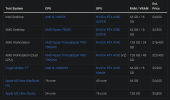Extremely impressive -- really goes to show that the M3 and A17 was a stop-gap solution.Geekbench 6 benchmarks starting to appear.
This one shows us the M4 (base frequency 4.4GHz) in an iPad solidly trouncing the M3 series in single-core and matching the M3 Pro in multi-core.
Single-Core score: 3810 (20% increase over M3)
Multi-Core score: 14541 (25% increase over M3)
It seems that Geekbench 6.3 introduced support for the Arm Scalable Matrix Extensions (SME) and the M4 finally exposes that for applications.
It's the fastest single-core performance in any hardware available in any form factor today, be it server rack, desktop computers or anything else for that matter. This is just in a 5,1mm thin tablet
The performance per watt is really great.
I fully except a transition of the entire Mac lineup to the M4 -- though I still have a lot of questions about how they're going to handle the Mac Pro. If that thing doesn't support PCIE GPUs or swappable ECC-RAM, then it's a waste of space.



